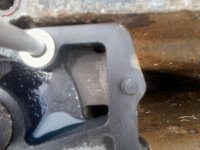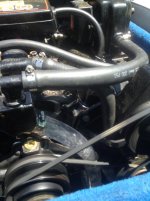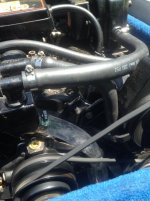Greetings, Members! There are several posts regarding this topic, but wanted to do a refresh and ask for everyone’s help – I am at a loss at the moment.
Equipment: 1984 Sea Ray Monaco (purchased from the original owner in 1990); Mercruiser 5.7, serial number 6732604 – with Alpha I outdrive. Raw Water cooling system. Environment: Fresh water only – never in saltwater.
Symptoms - Beginning at the end of last year’s boating season here in Middle Tennessee, the engine temperature at the gauge would rise to just under “hot” at an estimated 3000 rpm (sorry, the tach is in-op). Any speed above a “slow plane” and the temp would head to hot. Backing off on the throttle and the temp would quickly decline to “normal” (Note: my temp gauge is marked in four sections: “C”| | (normal range)| | hot – My normal operating temp has always been slightly below or at the second “|”)
Attempted Repairs: Although I replaced the complete water pump in the spring of 2013, I suspected a problem with the pump and just kept it slow for the remainder of the season. This spring, I pulled the boat out for season make-ready maintenance which includes pulling the entire drive, checking for evidence of seal failure, check engine alignment, grease u-joints and replace the complete water pump assembly. Breakdown and inspection of the water pump revealed no vane damage or clogs. I replaced the complete water pump, back-flushed from the power steering cooler (replaced 2012) back, checked the tube / hose from the bell housing to the transom for cracks, clogs and damage – all appeared to be OK. I also made sure that the drive to bell housing “O” ring was in place at tear down and replaced (I use a touch of bellows cement to keep it in place for re-assembly. I also read somewhere that if the ignition timing was off, that too could contribute to the problem so I checked the timing which was OK and to spec. Took it to the lake – No change, pulled it out and brought it back home.
From other research, I decided to check the manifolds and risers. I was so confident that this was the cause that I bought new ones. I pulled both risers and one (port side) manifold and was amazed to find just a little rust, no scale and clear passages. I loaded up the parts that I pulled off and headed to the oldest Mercruiser dealer in Nashville. The mechanic (20+ years at the same dealership) inspected the parts and said “that’s not your problem - these are in great shape” and told me to drop in a new (140degree) thermostat and check the hoses, pick-up etc for obstructions. Also suggested that I pull the water supply hose, while in the lake and look for good flow, “head pressure” as he called it.
So while I had the darn thing torn down, I checked the condition of the flappers, they were only three years old, in good shape but replaced them anyway and looked into the “Y”pipe as far as I could for obstruction then flushed it with a garden hose. There was no water back-up, so I decided all was OK. Using new gaskets, I reinstalled the old manifold and risers and dropped in a new thermostat from the dealer. I attached a garden hose to the fresh water inlet hose (connects to thethermostat housing) and applied some pressure and looked for evidence of water seepage at the inlet tube at the transom – nothing found – everything stayed dry, so I headed to the lake. – No change other than the idle and slow operating temp is now slightly above the second |.
Pulled the inlet hose, started the engine – Appears to be a full flow at idle and a considerable increase at a higher RPM. At a slow cruise, temps (not at the overheat condition) using an I.R. temp gun:Thermostat housing top 142; circulation pump – top, starboard side 150; intake manifold, starboard, slightly to the rear of and below carb 180; port manifold 120, riser 119; Starboard - Manifold and riser 130.
Other: Replaced circulation pump approx 3-4 years ago. No indication of leaks or bearing / seal failure.
That’s my story - Please, please, please HELP!!! Thanks!!
Equipment: 1984 Sea Ray Monaco (purchased from the original owner in 1990); Mercruiser 5.7, serial number 6732604 – with Alpha I outdrive. Raw Water cooling system. Environment: Fresh water only – never in saltwater.
Symptoms - Beginning at the end of last year’s boating season here in Middle Tennessee, the engine temperature at the gauge would rise to just under “hot” at an estimated 3000 rpm (sorry, the tach is in-op). Any speed above a “slow plane” and the temp would head to hot. Backing off on the throttle and the temp would quickly decline to “normal” (Note: my temp gauge is marked in four sections: “C”| | (normal range)| | hot – My normal operating temp has always been slightly below or at the second “|”)
Attempted Repairs: Although I replaced the complete water pump in the spring of 2013, I suspected a problem with the pump and just kept it slow for the remainder of the season. This spring, I pulled the boat out for season make-ready maintenance which includes pulling the entire drive, checking for evidence of seal failure, check engine alignment, grease u-joints and replace the complete water pump assembly. Breakdown and inspection of the water pump revealed no vane damage or clogs. I replaced the complete water pump, back-flushed from the power steering cooler (replaced 2012) back, checked the tube / hose from the bell housing to the transom for cracks, clogs and damage – all appeared to be OK. I also made sure that the drive to bell housing “O” ring was in place at tear down and replaced (I use a touch of bellows cement to keep it in place for re-assembly. I also read somewhere that if the ignition timing was off, that too could contribute to the problem so I checked the timing which was OK and to spec. Took it to the lake – No change, pulled it out and brought it back home.
From other research, I decided to check the manifolds and risers. I was so confident that this was the cause that I bought new ones. I pulled both risers and one (port side) manifold and was amazed to find just a little rust, no scale and clear passages. I loaded up the parts that I pulled off and headed to the oldest Mercruiser dealer in Nashville. The mechanic (20+ years at the same dealership) inspected the parts and said “that’s not your problem - these are in great shape” and told me to drop in a new (140degree) thermostat and check the hoses, pick-up etc for obstructions. Also suggested that I pull the water supply hose, while in the lake and look for good flow, “head pressure” as he called it.
So while I had the darn thing torn down, I checked the condition of the flappers, they were only three years old, in good shape but replaced them anyway and looked into the “Y”pipe as far as I could for obstruction then flushed it with a garden hose. There was no water back-up, so I decided all was OK. Using new gaskets, I reinstalled the old manifold and risers and dropped in a new thermostat from the dealer. I attached a garden hose to the fresh water inlet hose (connects to thethermostat housing) and applied some pressure and looked for evidence of water seepage at the inlet tube at the transom – nothing found – everything stayed dry, so I headed to the lake. – No change other than the idle and slow operating temp is now slightly above the second |.
Pulled the inlet hose, started the engine – Appears to be a full flow at idle and a considerable increase at a higher RPM. At a slow cruise, temps (not at the overheat condition) using an I.R. temp gun:Thermostat housing top 142; circulation pump – top, starboard side 150; intake manifold, starboard, slightly to the rear of and below carb 180; port manifold 120, riser 119; Starboard - Manifold and riser 130.
Other: Replaced circulation pump approx 3-4 years ago. No indication of leaks or bearing / seal failure.
That’s my story - Please, please, please HELP!!! Thanks!!




